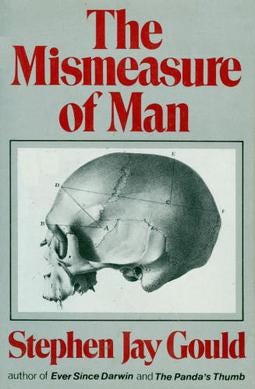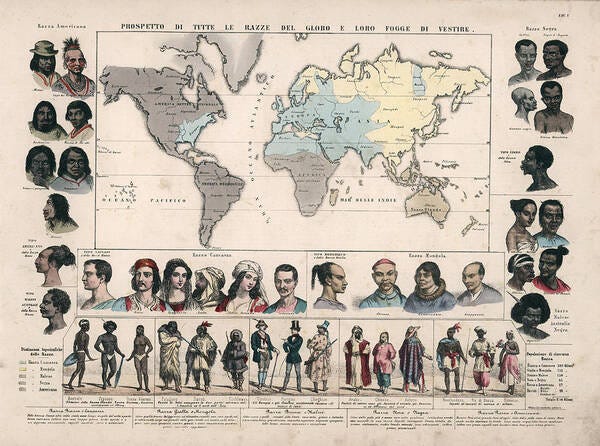One of my weaknesses as a writer is that I tend to use words nobody knows and discuss ideas nobody cares about. You’re supposed to write what you know about though, so I try to make it work.
One of the things I write about fairly often is anthropology, but anthropology as it was understood in the eighties and nineties, because that’s when I studied it, which means I’m mostly referencing books from the sixties and seventies which puts me way the heck out of date, to the point where whatever I say is more of a quaint curiosity than anything else.
I have read two evolutionary biologists. One is Richard Dawkins, who wrote “The Selfish Gene” and created the theory of memology. The other is Stephen Jay Gould, who wrote “The Mismeasure of Man,” which discusses how ethnographic studies are dangerous because they can lead to racial stereotypes.
Ethnographism now focuses mainly on cultural mores and practices, but in the eighteenth and nineteenth centuries, its main focus was to try to draw maps of the human race based on physical characteristics, which they then attached to (what they called social characteristics) but were actually stereotypes drawing moral conclusions, most of which put white Europeans at the top of a very large pyramid.
Gould found this ranking of people dangerous, and his work, particularly his work in “The Mismeasure of Man,” is one reason why physical characteristics are not discussed as much in current ethnographic discussions. Gould believed the practice could only end in Eugenics, which is probably right. The whole field of ethnography is fraught with landmines. If I were a teacher, I would just avoid it. I’m a writer, though.
I write about cultural and ethnic differences in people quite a bit for two reasons. The first is that, no matter how enlightened you are, this is still what you notice first. “You know Ellen, she’s the Asian chick in third-period biology.” “Mike’s the really tall black guy that hangs out with Omar. He’s so sweet.”
The other reason I write about it is that there’s this theory that, as people become more and more mobile, ethnicities and genetic differences are boiling down into one big gumbo. You can see it happen. People got really pissed when Kamala Harris described herself as Indian, and then they got really pissed when she described herself as black. That these criticisms come from the second most racist presidential candidates in my lifetime (David Duke is still first) might be an indication of the things Gould was trying to say. People resist this amalgamation of ethnography, and while I’ll miss ethnic divisions when they’re gone, it’s most likely for the best.
When I write about Ethnographic differences in people, I try to be really sensitive about how they’re perceived, and I also try to do most of it in describing my own people. The concept of prejudice and racial criticism of Celtic people seems quaint and made-up now, but there were times when it was very real. My people didn’t leave Scotland and Ireland because we didn’t like the weather (although it kind of sucked). We left because other ethnicities to the south were making our lives very difficult, and we thought maybe it’d be different in the new world. These are pretty much the same reasons why the twenty million people Donald Trump wants to round up and put on trains back to Mexico came here. I use the descriptor of rounding people up and putting them on trains specifically to suggest another time when the same thing happened.
When Lance Goss was getting ready to direct his second-to-last play, I sat in his office and discussed the kids who came to auditions. One was a tall, slender nineteen-year-old who might now be the dean of the college. Lance asked me what I thought about her, and I said we should “give her a dirk and a claymore and do Brigadoon.” That sounds like we’re speaking in some sort of secret theater code for gay or something, but what it really meant was that this woman physically looked like a very specific subset of the Celtic people that’s often called a “Ginger Scott.”
Gwen Verdon was a Ginger Scott, and so were Lucille Ball and Anne Margaret. Long of limb and square of hip, they can make really good dancers. The male corollary of a Ginger Scott has a bushy, bushy beard. They tended to paint themselves blue and frighten the Romans and the English by lifting their kilts and swinging a sword called a “claymore” that was longer than your mum is tall.
I use a phrase sometimes that’s pretty seldom used these days, so a lot of people have no idea what I’m talking about. The actual origins of the “Black Irish” are the subject of several myths. My favorite is that when the English (with Irish Sailors) sank the Spanish Armada, the Spanish sailors had no way to get home, so they settled in Ireland and took Irish wives. Genetic studies have rendered this theory mostly garbage, but it’s such a great story that I still use it.
I went to see Sam Sparks’ production of “Picnic” last night. It is a great show, and it won the Pulitzer for William Inge. In the film, Rosalind Russell plays Rosemary. Russell went on to be in “Mame” and “Mourning Becomes Electra.” She was an amazing actor, and Rosemary is one of the meatier parts in the show. She gets to show regret and pathos and a bunch of other opportunities to chew the scenery.
I’d never met this woman before, but I almost crossed myself when I saw her. She was one of the clearest examples of Black Irish I ever saw. Jet black hair and alabaster skin, I just wanted to give her a pom tam and sign her up for the Sinn Féin. None of that makes sense in the modern world. “The Troubles” have been over for a while, but there was a time when most of the world’s terrorism happened in Ireland. My people, it seems, can be difficult to get along with. Ask the McDonalds what happened in Glencoe.
Without a shred of proof, I’m going to guess that the Black Irish is a genetic variant of the Ginger Scott. They come from the same part of the world, and they have very specific skeletal similarities and skin tones. The main difference between them seems to be the color of the hair follicle at the base, and that could easily be a genetic variant.
That’s not nearly as interesting a story as marooned Spanish Sailors, but it makes more sense. There’s a theory, with some level of proof but still a lot of arguments, that the Ginger Scott represents vestiges of Neanderthal peoples, particularly those who settled in Germanic areas and ended up in Scotland and Ireland traveling in Norse Ships. That sounds incredibly convoluted, but if you look at how human beings spread out from Africa through the world, it’s very possible.
Ethnography is dangerous when you start attaching moral qualities to physical characteristics. This is what Gould warned against. I sometimes make jokes about how Celtic people will stick a knife in ye to show their affection, but I should probably be careful about that.
Everybody just thinks of us as “white” these days, and once they start calling you “white,” things get a lot easier. That’s actually pretty fucking evil, but it’s also true. When John Kennedy was elected president, there were still lots of people in America willing to call his people “broom pushers.” With him being Irish and a papist and all, there were folks here who had something to say about a mick president.
People had something to say about a part Black and part Indian president, too. I guess things don’t change much. When we had a part “Black” and part “White” president, the current president tried to say he wasn’t born here and his wife was a man. On Facebook just the day before yesterday, I saw a man who graduated from the University of Mississippi posting a meme about Michelle Obama’s testicles.
People ask me sometimes if I still believe Donald Trump is a fascist. My answer is that the future remains to be seen. Anyone can become anything on any day, and while I hope there won’t be a fascist revival in the United States if it walks like a duck and quacks like a duck, then it might be a duck. That’s a phrase often attributed to Ronald Reagan talking about communists in Central America, but it might be anecdotal.
I don’t think there’s anything inherently dangerous in discussing even the physical aspects of ethnography, so long as you make an effort to educate yourself on what it actually means (and, more importantly—what it doesn’t mean) and fight like hell not to attach moral implications for ethnicity.
Last night at the show, I said, as I’ve said many, many times since Tuesday, “America has been through questionable and challenging times before.” one of my own masters looked me dead in the eye and said, “I think it’ll be worse.” If she’s right, she’s right. We’ll survive either way, although maybe all of us won’t. On days like this, you hear a lot of people talking about Ann Frank. When they start talking about deporting twenty million people, then it’s very likely there will be reasonable people hiding little girls in their attic to keep them alive.
Most people won’t get through my first six paragraphs about anthropology to reach the part where I talk shit about their orange god. That’s ok. Being a boring writer sometimes means you get to say things others don’t.






